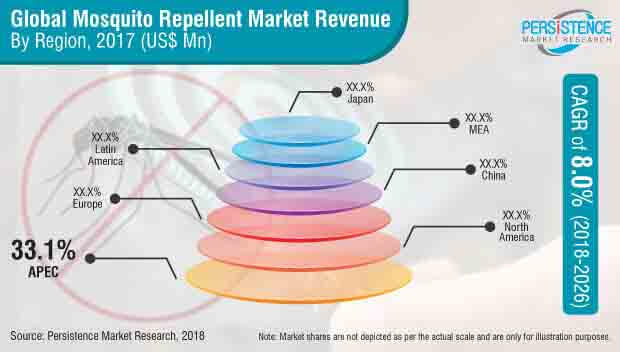Mosquito Repellent Market Forecast & Global Industry AnalysisPosted by Pradnya on April 15th, 2021
The impact of COVID-19 pandemic can be felt across the chemical industry. The growing inability in the production and manufacturing processes, in the light of the self-quarantined workforce has caused a major disruption in the supply chain across the sector. Restrictions encouraged by this pandemic are obstructing the production of essentials such as life-saving drugs. The nature of operation in chemical plants that cannot be easily stopped and started, makes the operational restrictions in these plants a serious concern for the industry leaders. Restricted and delayed shipments from China have created a price hike in the raw materials, affecting the core of the chemicals industry. The slacking demand from different impacted industries such as automotive is negatively influencing the growth of the chemical industry. In light of the current crisis, the market leaders are focused to become self-reliant which is expected to benefit the economic growth of different economies in the longer term. Companies are triggering events to restructure and recover from the losses incurred during the COVID-19 pandemic. Environmental changes such as land-surface characteristics and variation in climate, along with increased anthropogenic activities comprising mining, deforestation, mining, and human mobility, have resulted in an increase in vector-borne diseases including dengue virus, Zika virus, and malaria, over the years—thereby driving the sales of mosquito repellents. As per a recently published study on the global mosquito repellent market, by Persistence Market Research (PMR), developing economies are projected to exhibit high adoption of mosquito repellents, with APEC leading the suit. As per the report, APEC and China together account for approximately half the volume and value share—the demand further projected to grow at a significant CAGR. Global sales of mosquito repellents is expected to generate a valuation of US$ 4 Billion, in 2019 and the global volume sales (in million units) is studied to increase 1.8x, standing at 54,406 Mn units, during the same period. The overall market for mosquito repellents is expected to expand a robust CAGR of 8 percent, in terms of value, through 2018-2026, considering:
APEC and China Continue to Witness Substantial Demand With a market share of over 36 percent along a substantial incremental opportunity projection, APEC is likely to remain the most lucrative, revenue-generating pocket for mosquito repellents. India, after the rest of APEC, is projected to gain high basis points— expanding its market share further. In terms of overall incremental opportunity created over the forecast period of 2018-2026, India is expected to represent a share of approximately 50 percent. Other than India, countries, such as South Korea, Malaysia, Bangladesh, amongst others, are projected to witness significant growth in demand for mosquito repellent products, in the coming years. China, on the other hand, is projected to be positioned in the high volume and value growth quadrant, considering the increasing urban congestion in the region. Apart from the emerging markets, North America, followed by Europe, will observe moderate growth in the mosquito repellent market. Opportunity Analysis: “PMR foresees significant growth opportunities in rural and developing markets, considering the widespread availability of non-branded mosquito repellents in India. Manufacturers are increasing their revenue share in low income developing regions by launching relatively cheaper and more effective products such as Good Knight Fast Cards, roll on, wipes by S.C. Johnson and Sons and Godrej Consumer Products Limited. These cards are available for 1 rupee each, burns instantly for 3 minutes, does not produce smoke, and can prevent mosquitoes up to 5 hours. In addition, cream-based mosquito repellents are expected to remain the most favored products, holding a market share of over 53 percent, in 2018. However, low toxicity and high repellent action will create significant market demand for vaporizers, in the coming years”, explains a senior analyst. Bio-Based, Herbal Mosquito Repellent Formulations Gain Preference Although N,N-Diethyl-3-methylbenzamide, also called DEET, provides protection against a range of insects, including mosquitoes, fleas, leeches, and ticks, several studies indicate its harmful effect on the human nervous system. Currently, accounting for a relatively small volume share in the global mosquito repellent market, the bio-based segment, by source, will expand at a promising CAGR of over 8.5 percent, retaining its position, in terms of growth, over the forecast period. To counter the ill effects of synthetic mosquito repellent products, manufacturers are developing natural mosquito repellents which are as effective as synthetic mosquito repellents. For instance, some soy-based repellents are known to offer longer protection than low-concentration DEET products. Most mosquito repellents contain petroleum, parabens, phthalates among other synthetic chemicals, leading to skin allergies and reactions. Oil and Lamon Eucalyptus (OLE) is a plant based repellent which has been shown to have similar protection to lower concentration of DEET. Manufactures are also using natural repellent actives such as essential oils which present low toxicity, instead of chemicals to manufacture mosquito repellent. Mosquito Repellent Market Showcases a Moderately Consolidated Landscape Tier-1 manufacturers including
hold approximately 50-60 percent of the total market share. The tier-1 players are have a diversified product portfolio and supply different forms and varieties of mosquito repellent for urban and rural regional areas. Tier-2 manufacturers of mosquito repellents, account for nearly 25-30 percent of the overall market—having a relatively smaller production capacity and limited regional presence. Tier-2 manufacturers include Coghlan, Omega, Jyothy Laboratories, Global Consumer Products Private Limited, and Avon Product Inc. Holding around 10-15 percent of the overall market, tier-3 players are the smaller domestic players, having limited product offering and regional presence. The core differentiation strategies include: For in-depth competitive analysis, buy now@ https://www.persistencemarketresearch.com/checkout/25825 Like it? Share it!More by this author |



